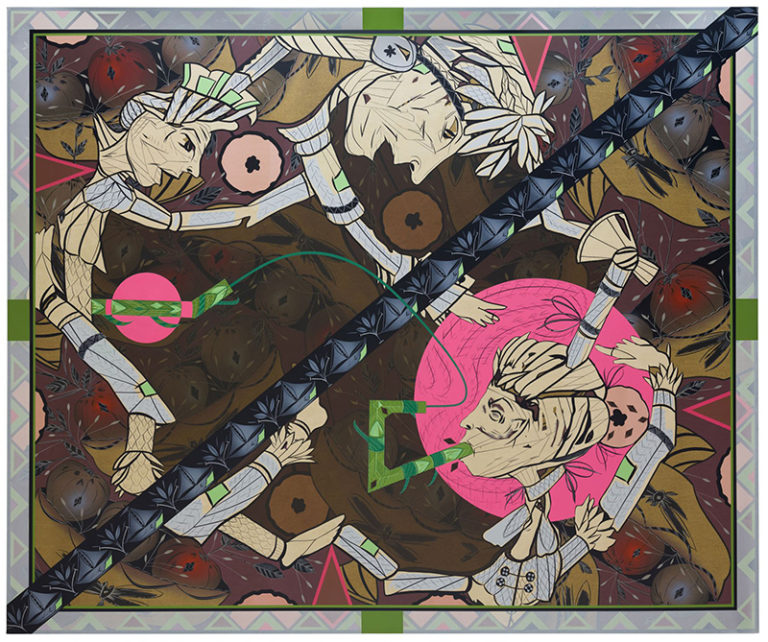Fast on the heels of Lari Pittman’s most comprehensive solo exhibition in decades, which ran until January at the Hammer Museum in the artist’s hometown of Los Angeles, “Found Buried” is his first at New York City gallery Lehmann Maupin. The exhibition features a brand new set of large-scale paintings and a subset of smaller works on paper, all of which were produced in 2020 and provide a timely, fascinating glimpse into Pittman’s practice of late. “Found Buried” resumes with the thematic concerns, graphics, materials and methods with which Pittman has long been preoccupied in his practice.
As a gay man of Colombian-American descent, many of Pittman’s concerns have manifested in the thematic content of his work: a dialogue with his own sexuality and identity. Pittman’s work has also long displayed his personal interests in historical injustices like the HIV/AIDS epidemic and those found in gender relations. This show continues this legacy of responding to legacies of past injustices — its overall iconography and aesthetic suggests themes relating to the colonial American project. The paintings are large, and half of them feature humanoid figures and familiarly rendered objects amidst seemingly chaotic compositions. The other half prominently feature Pittman’s characteristic patterns and motifs of the decorative and applied graphic arts. Accompanying the paintings are a subset of smaller works on paper, distinct in content and composition: portrait-like profiles are the center of focus, and color schemes range between muted reds and browns.
The series is split between those numbered and those subtitled. People and objects feature prominently in the former. Humanoid figures are rendered akin to straw dolls, positioned like marionettes, seemingly lifeless but not fully so. They are clothed in either Native American or colonial dress, possibly both. In Found Buried #1, a figure is splayed on the upper half of a pictorial field, looking sick or mutilated and is bent over vomiting something cryptic and flesh-colored that could be seen as an extension of its body. It is enclosed by an oval of axes and surrounded by the steeple-dome-roofs of old buildings. Elsewhere, elements such as an antique automobile, a sailboat—of the type Pittman is so fond of utilizing, a volleyball and a bird icon encased in a solid light green circle, float about. A floral pattern of muted reds, blues and whites functions as the connective tissue between the elements.

LARI PITTMAN, Found Buried #2, 2020
The evocation of a floating body or figure is echoed in #5, this time over a landscape of towns and mountains; the architecture and aesthetic of which has the feel of the rustic and folk. The figure holds a pipe in its mouth, its headdress made of feathers, unsettlingly, it is tied by its neck and limbs by rope. Doing away with full-body figures, #9 offers up an interesting arrangement of profiles similar to the works on paper, all smoking pipes and wearing feathery headdresses, Pittman’s oft-utilized lamps occupy the edges, while an abstract symbol of bright cyan against orange shocks from the homely but beautiful brown-and-gray floral pattern just beside it.
Among the subtitled paintings, Textile for Casket Lining, has Pittman composing and conjuring with sailboats and scissors, complex shapes complementing the interactions of blacks, browns and yellows, with touches of reds and blues. This imagery of domestic material culture likewise features centrally in sibling paintings like Textile for a Courtroom and Textile for a Prison, where hammers, painted eggs, straw-filled miniature birds, scissors and flowers in tones of blue pop out amidst layered patterning. The subtitles of the paintings point to the everyday goings-on of human activity—events, customs, institutions—from crib linings to courtrooms, wedding dresses, hospitals and even revolutions.
The paintings and works on paper in “Found Buried” feature much of the visual vocabulary Pittman’s work has been known for. Legacy and the contemporary are provocatively conjured through a singular iconographic-oriented idiom, potently expressed through the artist’s ever rich and intricate multimedia paintings.



















0 Comments